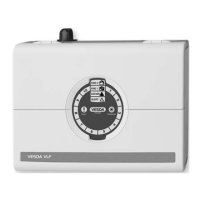VESDA VLF-500-UL 7Ed Product Guide VESDA
iv www.xtralis.com
Configuring Detector Thresholds for UL 268 Ed7 standard Compliance
OPEN AREA
Introduction of ANSI standard UL268 7
th
edition, which now includes a nuisance alarm requirement for which the
detector is not permitted to signal an alarm during UL defined nuisance fire conditions.
Xtralis VESDA detectors support four configurable alarm thresholds:
l Fire1 Alarm threshold, used to signal the alarm condition, each sampling port must be configured to be:
o
Above the nuisance smoke level
o
Below the smoke alarm level.
l Alert and Action configuration is not subject to the UL 268 Ed7 standard requirement and remain available
for signaling at a higher sensitivities.
l Fire 2 configuration is not subject to the UL 268 Ed7 standard requirement and remains available for
signaling lower sensitivities.
To correctly set the VLF-500-UL aspirated detector system smoke alarm threshold, the pipework design must be
analyzed so that the applicable detector alarm threshold can be calculated to meet both the nuisance and alarm
criteria for every sampling port within the system.
ASPIRE
Xtralis provides the Aspire pipe modelling tool to analyze pipework designs to achieve compliance to different
standards across the world.
Each sample hole is reported with a transport time and a sensitivity.
For UL 268 Ed7 standard compliance, the pipework design shall ensure that the:
l Transport time for each sampling hole is less than the applicable maximum transport time specified in Table
1.
l Sensitivity of each sampling hole is within the applicable minimum and maximum hole sensitivity specified
in Table 1.
The alarm threshold settings generated with Aspire must be applied to the detector configuration to meet this
compliance objective.
The design and installation of pipework in any practical site will result in holes with a range of sensitivity dependent
on the actual airflow entering the system through each sample hole.
Xtralis recommends a balance of at least 55% to ensure that designed pipework systems include a sufficient safety
margin for reliable operation when deployed. This means that the ratio between the minimum sensitive hole and
the maximum sensitive hole is not more than 1:2. This ratio allows sufficient flexibility so that installers can install
the pipework systems using common drill sizes and techniques appropriate for the job site. Whilst it is
recommended to target tighter balance 70% recommended, this is unlikely to be realized in practice.

